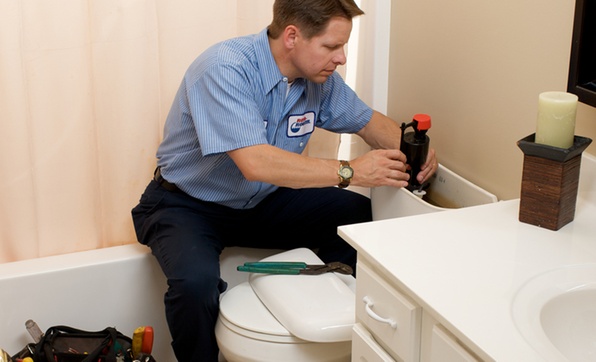New Homeowners: Crucial Tips for Your Bathroom Plumbing
New Homeowners: Crucial Tips for Your Bathroom Plumbing
Blog Article
We've noticed this great article about Smart Plumbing Tips for New Homeowners down the page on the web and accepted it made perfect sense to discuss it with you in this article.

For new home owners, understanding and keeping washroom plumbing can save both money and time by avoiding costly problems down the line. Here are some important bathroom plumbing ideas to aid you maintain whatever running smoothly.
Plan For Winter
Safeguard your pipes from cold throughout cold weather by shielding pipelines in unheated locations like cellars, attics, and garages. During extreme cold, let cold water drip from faucets offered by revealed pipelines to aid protect against freezing.
Schedule Normal Upkeep
Consider organizing annual assessments with a certified plumbing. They can find problems that you could miss, such as covert leakages or wear and tear on pipes and fixtures. Regular upkeep aids expand the life of your pipes system and can stop emergencies.
Familiarize Yourself with the Key Shut-Off Valve
Understanding where the major water shut-off valve lies in your home is crucial. This allows you to quickly shut off the water in case of major leaks or during pipes emergencies, preventing comprehensive water damages.
Routinely Inspect for Leakages
Tiny leakages can lead to big troubles. Regularly examine under sinks, around commodes, and near plumbing fixtures for any indicators of leakages. Search for moisture, little drips, or corrosion. Catching and repairing leaks early can avoid much more significant damages and conserve water.
Keep Your Water Heater
Ensure your hot water heater is set to an appropriate temperature level (usually around 120 degrees Fahrenheit) to stop hot and minimize power usage. Flush the storage tank each year to get rid of debris build-up, which can minimize the efficiency and lifespan of your heating unit.
Upgrade Your Components
If your home has older components, think about upgrading to much more efficient models. Modern bathrooms, showerheads, and faucets are designed to utilize much less water while offering excellent stress, which can significantly lower your water bill and environmental impact.
Beware with DIY Plumbing Fixes
While it's tempting to take care of all home repairs on your own, be cautious with pipes. Some issues could require expert expertise, particularly if they involve major water lines or drain fixings. Employing an expert can sometimes be more affordable than do it yourself, particularly if it avoids more damage.
Do Not Disregard Slow Drains
If your sink or bath tub is draining pipes slowly, it's often a sign of a blockage creating. Resolving this early can prevent a complete blockage. Use a plunger or a plumbing professional's serpent to clear out particles. Avoid using chemical drainpipe cleansers as they can damage your pipes gradually.
Know What Not to Flush
Toilets are not waste disposal unit. Stay clear of purging anything besides toilet tissue and human waste. Items like wipes, feminine health products, and cotton bud need to be gotten rid of in the garbage to avoid clogs and sewer back-ups.
Install Strainers in Drains
Location strainers in your sink and bathtub drains pipes to catch hair and various other particles prior to they enter your plumbing system. Cleaning the filters on a regular basis will aid avoid buildup and maintain water streaming easily.
Verdict
Comprehending and maintaining your home's shower room plumbing can avoid several common problems. By complying with these important ideas, you can ensure your bathroom remains useful and efficient, conserving you money and time in the long run.
Essential Plumbing Tips for Homeowners: Keep Your Pipes Flowing Smoothly
As a homeowner, understanding the basics of your plumbing system can save you time, money, and a lot of headaches. Plumbing issues can range from minor annoyances like dripping faucets to major problems like burst pipes that cause significant damage. This guide provides essential tips to help you maintain your plumbing system and tackle common issues.
Understanding Your Plumbing System
Supply System: Brings fresh water into your home from a municipal source or a well. Drain-Waste-Vent System: Removes wastewater and vents sewer gases outside. Fixtures and Appliances: Includes sinks, toilets, showers, dishwashers, and washing machines. Basic Maintenance Tips
Regular Inspections: Periodically check for leaks, corrosion, and other signs of wear and tear. Look under sinks, around toilets, and near water heaters. Know Your Main Shut-Off Valve: In case of a major leak, you’ll need to shut off the water quickly. Ensure everyone in your household knows where the main shut-off valve is located. Prevent Frozen Pipes: In cold climates, insulate exposed pipes and let faucets drip during extreme cold to prevent freezing. Use Strainers: Install strainers in sinks and tubs to catch hair, food particles, and other debris that can cause clogs. Common Plumbing Issues and Solutions
Clogged Drains:
Prevention: Avoid pouring grease down the drain and use drain screens to catch debris. DIY Fix: Use a plunger or a plumbing snake to clear minor clogs. For stubborn clogs, a mixture of baking soda and vinegar can sometimes help. Leaky Faucets:
Prevention: Replace washers and seals regularly. DIY Fix: Turn off the water supply, disassemble the faucet, and replace worn parts.

Explore Report this page